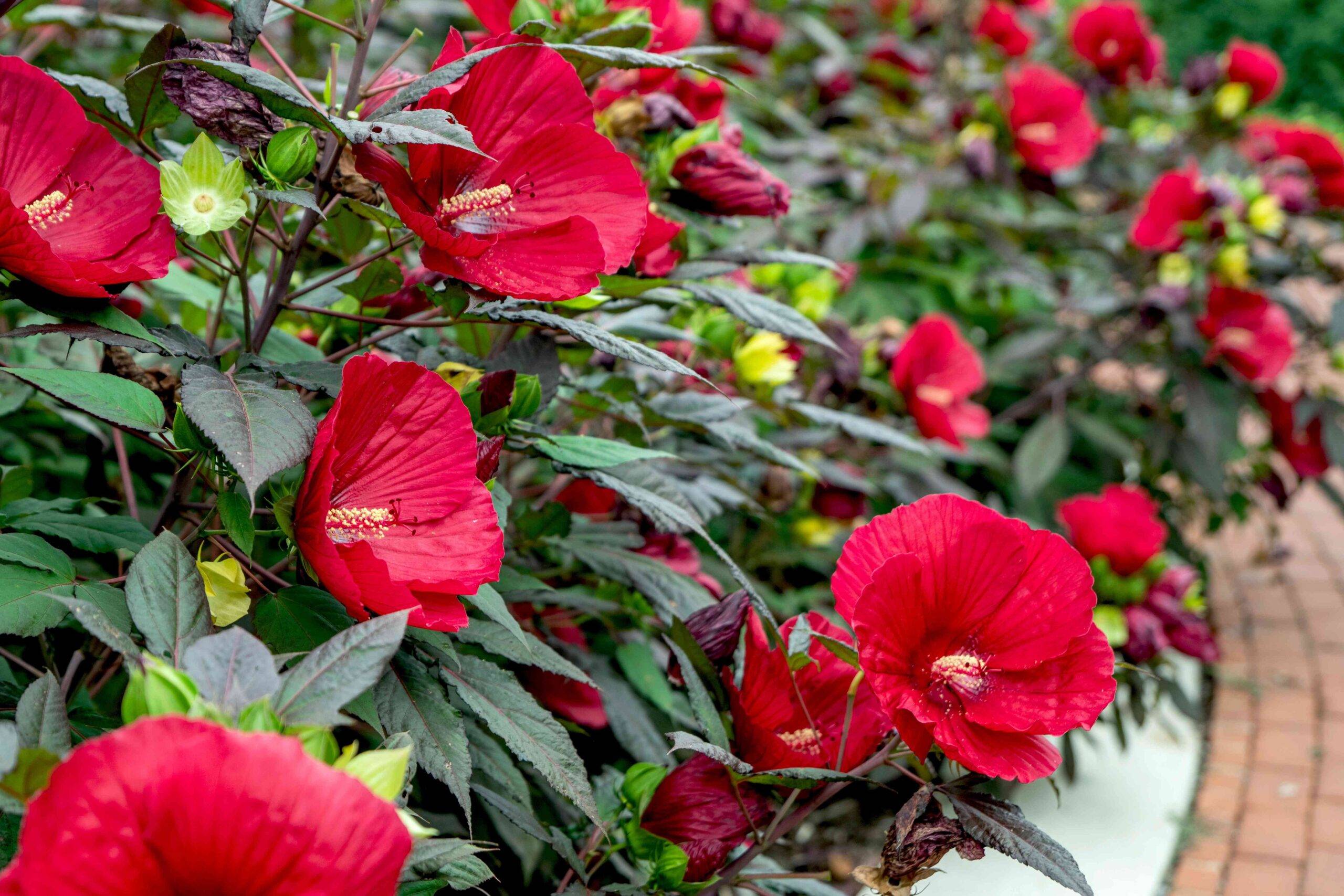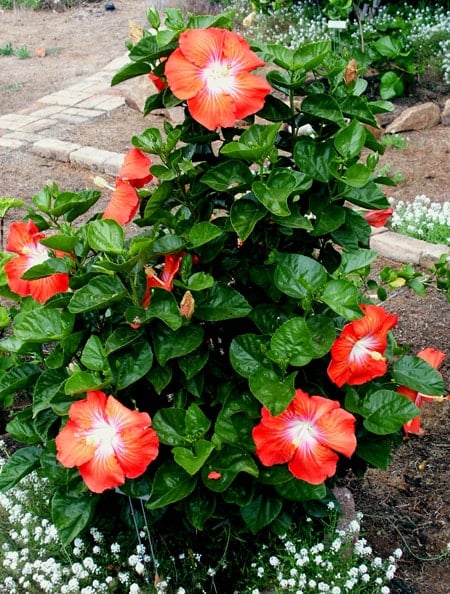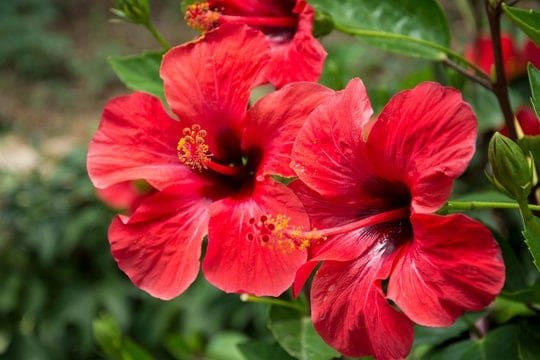
Chinch Bugs vs. Sod Webworms: Spotting the Difference in Your Florida Lawn
Whether you’re a new homeowner in Florida or a long-time resident, you already know that conditions in the Sunshine State…

Florida’s lush landscapes are often adorned with the vibrant, trumpet-shaped flowers of hibiscus plants. These tropical beauties are a favorite among gardeners and homeowners alike, adding a splash of color and exotic flair to gardens across the Sunshine State. However, to keep these plants thriving and blooming at their best, proper care and fertilization are essential. In this comprehensive guide, we’ll explore the ins and outs of hibiscus care in Florida, with a particular focus on fertilization timing and best practices.
Hibiscus plants have found a special place in the hearts of Florida gardeners, and for good reason. These versatile shrubs are well-suited to the state’s warm, humid climate, making them a popular choice for both residential and commercial landscapes. Native to various tropical and subtropical regions, hibiscus belongs to the Malvaceae family and offers a wide array of colors, sizes, and growth habits.
In Florida, hibiscus thrives in the state’s sandy soils and warm temperatures, adapting well to various light conditions from full sun to partial shade. They’re particularly well-suited to coastal areas, where they can tolerate salt spray and sandy soils. While many hibiscus varieties are non-native, there are also several native Florida hibiscus species that are perfectly adapted to the local ecosystem.
The key to successful hibiscus cultivation in Florida lies in understanding their specific needs, including soil pH, watering requirements, and, of course, fertilization. By providing the right nutrients at the right time, you can ensure your hibiscus remains healthy, vibrant, and ready to put on a spectacular show throughout the growing season.

Timing is crucial when it comes to planting hibiscus in Florida. The ideal planting time can vary depending on the specific region within the state and the type of hibiscus you’re planting. However, there are some general guidelines that can help ensure your hibiscus gets off to a strong start.
Spring is generally the best time to plant hibiscus in Florida. The warming temperatures and increased daylight hours provide optimal conditions for root establishment and growth. Planting in spring allows the hibiscus to develop a strong root system before the intense heat of summer arrives.
North Florida: Aim to plant in late March to early April, after the risk of frost has passed.
Central Florida: Mid-March to early May is ideal for planting.
South Florida: You can plant as early as late February to early May.
Fall can also be a good time to plant hibiscus in Florida, especially in the southern parts of the state. The slightly cooler temperatures and typically more consistent rainfall can help new plants establish themselves before winter.
North Florida: Plant by early October to allow time for establishment before cooler weather.
Central Florida: Mid-September to early November is suitable for planting.
South Florida: You can plant throughout the fall season, from September to November.
Summer (June to August): The intense heat and potential for drought stress can make it challenging for newly planted hibiscus to establish. If you must plant during summer, be prepared to provide extra care, including frequent watering and shade protection.
Winter (December to February): While winters are mild in much of Florida, unexpected cold snaps can damage newly planted hibiscus. This is especially true in North and Central Florida.
Soil Temperature: Hibiscus prefers soil temperatures above 50°F (10°C) for optimal root growth. In most of Florida, soil temperatures are suitable year-round, but it’s worth checking if you’re in the northern part of the state.
Rainfall Patterns: Try to time your planting to coincide with periods of regular rainfall. This can help reduce the need for supplemental watering during the critical establishment phase.
Microclimate: Consider the specific conditions in your garden. Areas near buildings or water features may create warmer microclimates that allow for earlier planting or extended growing seasons.
Container Plants: If you’re transplanting hibiscus from containers, you have more flexibility in planting time. However, avoid transplanting during extreme weather conditions.
Native vs. Non-Native Species: Native Florida hibiscus species may be more adaptable to local conditions and can often be planted with greater flexibility throughout the year.
By choosing the right time to plant your hibiscus, you’re setting the stage for healthy growth and abundant blooms. Once your hibiscus is established, proper care, including timely fertilization, will be key to keeping it thriving in Florida’s unique climate.
In the next sections, we’ll delve deeper into the specifics of fertilizing hibiscus in Florida, including the best times to fertilize, the types of fertilizers to use, and how to adjust your fertilization practices based on your location within the state. Whether you’re nurturing tropical hibiscus in the balmy climate of South Florida or tending to hardy hibiscus in the slightly cooler North Florida region, this guide will help you keep your plants healthy, vibrant, and bursting with beautiful blooms year after year.
While many hibiscus varieties found in Florida gardens are non-native, the Sunshine State does boast its own native hibiscus species. The Hibiscus coccineus, also known as the scarlet rosemallow, marsh hibiscus, or swamp mallow, is the only hibiscus species native to Florida. This stunning plant is a testament to the beauty of Florida’s natural flora and offers several advantages for local gardeners.
Appearance: The scarlet rosemallow features large, striking red flowers that can reach up to 6 inches in diameter. Its deeply lobed leaves give it a unique, tropical appearance.
Height: This native hibiscus can grow quite tall, often reaching heights of 6 to 8 feet.
Habitat: True to its alternate names, this hibiscus thrives in wet, marshy areas and is often found near swamps, wetlands, and along stream banks.
Blooming season: It typically blooms from late spring through fall, providing a long-lasting display of vibrant color.
Wildlife benefits: The scarlet rosemallow is a valuable nectar source for butterflies and hummingbirds, making it an excellent choice for wildlife gardens.
Adaptability: Being native to Florida, this hibiscus is well-adapted to local climate conditions, including humidity, rainfall patterns, and temperature fluctuations.
Low maintenance: Once established, it requires less care and resources compared to non-native species.
Eco-friendly: It supports local ecosystems by providing food and habitat for native wildlife.
Drought tolerance: While it prefers moist soil, it can tolerate short periods of drought once established.
Salt tolerance: This native hibiscus has some tolerance to salt spray, making it suitable for coastal gardens.
Incorporating Hibiscus coccineus into your Florida garden not only adds a touch of local flair but also contributes to the preservation of native plant species. Whether you’re creating a wetland garden, a butterfly sanctuary, or simply want a low-maintenance, eye-catching plant, the scarlet rosemallow is an excellent choice for Florida gardeners.

Proper fertilization is key to maintaining healthy, vibrant hibiscus plants in Florida. While hibiscus can be relatively low-maintenance, a consistent fertilization schedule will ensure optimal growth and abundant blooms. In Florida’s unique climate, 3-4 applications per year have proven successful for most hibiscus varieties.
Here’s a general fertilization schedule for hibiscus in Florida:
Apply the first round of fertilizer as new growth begins to emerge. This initial feeding provides essential nutrients to support the plant’s awakening from winter dormancy.
Once the first burst of new growth has occurred, typically about 6-8 weeks after the initial fertilization, apply a second round of fertilizer to support continued growth and bud formation.
As the growing season reaches its peak, provide another fertilizer application to maintain vigor and promote continuous blooming.
In Florida’s mild climate, many hibiscus varieties continue to grow and bloom well into winter. A light fertilizer application at this time can help sustain the plant through the cooler months.
It’s important to note that this schedule may need to be adjusted based on your specific location within Florida, the type of hibiscus you’re growing, and local weather conditions.
For example:
In North Florida, where winters are cooler, you might skip the early winter application and instead focus on three applications during the warmer months.
In South Florida, where growing conditions are favorable year-round, you might extend your fertilization schedule with an additional light application in late winter.
Remember, while following a schedule is important, it’s equally crucial to observe your plants and respond to their needs. Signs of nutrient deficiency, such as yellowing leaves or stunted growth, may indicate that your hibiscus needs an extra boost of fertilizer.
Choosing the right fertilizer for your hibiscus is crucial for maintaining healthy, vibrant plants with abundant blooms. At Council Oxford, we understand that every garden is unique, and your hibiscus may have specific requirements based on your local soil composition, climate, and other factors.
Talk to an expert
That’s why we recommend speaking with our in-store experts who can provide personalized advice tailored to your specific situation. Don’t hesitate to give us a call or visit our store to find the right solution for your hibiscus and other plants.
For hibiscus planted directly in the ground, a balanced, slow-release fertilizer is often the best choice. We like using a light fertilizer like Milorganite when planting. Look for a fertilizer with an NPK ratio close to 10-10-10 or 5-5-5. These balanced formulas provide equal parts nitrogen (N), phosphorus (P), and potassium (K), supporting overall plant health, root development, and flower production.
At Council Oxford, we offer specially formulated hibiscus fertilizers that are ideal for in-ground plants. These often include additional micronutrients that are particularly beneficial for hibiscus, such as iron, manganese, and magnesium. Our experts can help you select the best option based on your soil type and the specific needs of your plants.
For established hibiscus plants that require regular feeding, a slightly higher potassium fertilizer can be beneficial. Potassium promotes flowering and helps strengthen the plant’s root system. We recommend a 10-4-10 fertilizer with micronutrients such as Iron and Manganese.
At Council Oxford, we offer both granular and water-soluble fertilizers suitable for regular application to hibiscus. Water-soluble fertilizers are excellent for providing a quick nutrient boost, while granular formulations offer a more sustained release of nutrients over time. Our knowledgeable staff can guide you on the best application methods and frequency for your specific situation.
Remember, the key to successful hibiscus fertilization is not just choosing the right product, but also applying it correctly. Over-fertilization can be just as harmful as under-fertilization, leading to excessive foliage growth at the expense of flowers, or even causing root burn. That’s why we always recommend consulting with our experts at Council Oxford to develop a fertilization plan tailored to your hibiscus and your garden’s unique needs.
Growing hibiscus in Florida can be a rewarding experience, but it does come with its challenges. Here are some expert tips to help you cultivate thriving hibiscus plants:
Pest Management: Always be on the lookout for insects such as whiteflies, mealybugs, and aphids. These pests can quickly infest hibiscus plants and cause significant damage. At Council Oxford, we always recommend using a systemic insecticide such as ImidaPro 2SC every 2-3 months to systemically defend against these insects. This proactive approach can save you a lot of trouble in the long run.
Watering: Hibiscus plants prefer consistent moisture but don’t tolerate waterlogged soil. Water deeply but less frequently to encourage deep root growth. In Florida’s sandy soils, you may need to water more often during dry spells.
Pruning: Regular pruning helps maintain the shape of your hibiscus and promotes bushier growth with more blooms. Prune in early spring before the main growing season begins.
Mulching: Apply a 2-3 inch layer of organic mulch around your hibiscus plants to help retain moisture, regulate soil temperature, and suppress weeds. Be sure to keep the mulch a few inches away from the plant’s stem to prevent rot.
Soil pH: Hibiscus prefers slightly acidic to neutral soil (pH 6.0-7.0). Test your soil regularly and adjust as needed. Our experts at Council Oxford can help you interpret soil test results and recommend appropriate amendments.
Sun Exposure: While hibiscus loves sun, in Florida’s intense heat, some afternoon shade can be beneficial, especially for varieties with darker-colored flowers which can fade in strong sunlight.
Winter Protection: Although hibiscus is well-suited to Florida’s climate, unexpected cold snaps can occur. Be prepared to cover your plants if temperatures are forecast to drop significantly, especially in North and Central Florida.
Container Growing: If you’re growing hibiscus in containers, choose a pot with good drainage and use a high-quality potting mix. Container-grown plants may need more frequent watering and fertilization than in-ground plants.
Companion Planting: Consider planting hibiscus alongside other tropical plants that have similar care requirements. This can create a cohesive landscape and simplify your garden maintenance routine.
Regular Inspection: Make it a habit to regularly inspect your hibiscus plants for signs of stress, disease, or pest infestation. Early detection and treatment can prevent many issues from becoming serious problems.
Remember, while these tips provide a good starting point, every garden is unique. That’s why we at Council Oxford are always here to offer personalized advice and product recommendations. Whether you’re a seasoned hibiscus grower or just starting out, don’t hesitate to reach out to our team for expert guidance on all aspects of hibiscus care in Florida.
By following these expert tips and maintaining a regular care routine that includes proper fertilization, watering, and pest management, you can enjoy healthy, vibrant hibiscus plants that add a tropical touch of beauty to your Florida landscape year after year. And remember, the team at Council Oxford is always here to provide personalized advice and product recommendations to help your hibiscus and entire garden thrive.